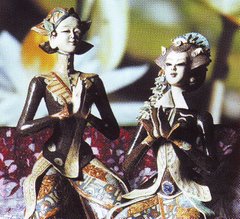Saturday, May 31, 2008
Sunday, May 25, 2008
wound
ILIB mode 7

ILIB mode 7



ILIB mode 0


ILIB mode 0

Friday, May 16, 2008
Mr Djoko- hearing loss


Mr Djoko, one of my patient, came to me 2 weeks ago. He suddenly loss his hearing at the left side. Laser given by ILIB and ear probe . After the first treatment, he felt “better”, no “full” sensation again on his lefl ear. Everyday laser for four times, and ones a week after the 4th , :
The audiogram after treatment : found normal
day 1: ILIB 30 mint; ear probe 30 min
day 2 : ILIB 40 min; ear probe 30 min
day 3 ILIB 50 min; ear probe 30 min
day 4 ILIB 60 min; ear probe 30 min
a week after: ILIB 60 min, ear probe 30 min
He already got stroke few years ago, his hearing loss could cause by ischemic. Lee and Baloh found that ten percent of patients with vertebrobasilar stroke had unilateral hearing loss, almost always with vertigo. Treatment with steroids has class I evidence for being a beneficial treatment--even if the cause turns out to be vascular. Usually tapering oral steroids are given, sometimes with pentoxifylline, and occassionally acyclovir or valacyclovir.
For Ms Djoko, the Laser combine with neurotopic agent
From jurnal:
The low level laser therapy of inner ear dysfunction has been made use of in Germany since the end of the eighties (for example by Dr. Uwe Witt, Hamburg and Dr. Lutz Wilden in Bad Fuessing) and is also to be found in quite a few other countries (Italy, France, Scandinavia, Switzerland, Hungary, Japan, Russia etc.). .
As the observation of healing processes has shown in the course of the years, even serious impairments such as the most excruciating cases of tinnitus, hearing loss, vertigo and Meniere's Disease can be considerably alleviated and even healed with the aid of modern Low Level Laser Therapy (LLLT).
How does LLLT work?
For a detailed discussion, see Dr. Lutz Wilden' article: Import of Radiation Phenomena of Electrons and Therapeutic Low-Level Laser in Regard to the Mitochondrial Energy Transfer, Journal of Clinical Laser Medicine & Surgery, Volume 16, Number 3, 1998, Mary Ann Liebert, Inc., Pp.159-165
Each cell contains a number of power plants, called mitochondria. The function of these power plants is to produce ATP, the form of energy which can be used by the cell to function properly.
The inner mitochondrial membrane is a large collector surface folded onto a small total volume. All nutritive molecules (fats, proteins and glucose) are oxidized within the cell to the last molecular nutritive component, that is, pyruvate. The pyruvate is then imported into the cellular power plant, where it disintegrates into carbon dioxide and water in the immediate proximity of the collector surface of the mitochondrion. The molecular bond energy thus released, which corresponds with visible, ultraviolet and infrared light as far as its wavelength and frequency is concerned, is utilized by the mitochondrion to produce the cellular fuel ATP.
The collector surface of our cellular power plant is enlarged by the mushroom-shaped protrusions of the inner mitochondrial membrane. The molecular bond energy of the pyruvate is released in the form of light energy. The antennae pigments are capable of absorbing this light energy and transmit it to our cellular power plant, which can now produce the cellular fuel ATP. The natural solar radiation also stimulates the antennae pigments of the mitochondrion to produce ATP.
Low level laser light is compressed light from the red and infrared spectrum of the electromagnetic radiation. It reaches the cellular power plants of low-lying cells as well and is absorbed by their collector surfaces as an additional source of energy. The cellular power plants can thus produce more ATP. The cellular energy is the fuel the inner ear cells strives after and needs. A sufficiently high supply of cellular energy enables our inner ear cell to work under optimum conditions and is the essential prerequisite to ensure a successful self-healing process.
Low level laser light increases the energy output in our cellular power plant.













